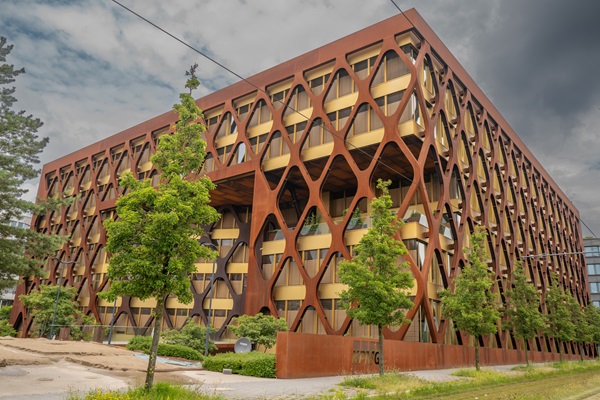 Credit: Ali SAHIB
Credit: Ali SAHIB
Luxembourg, nestled in the heart of Europe, boasts various architectural splendours, with several that nowadays combine history and contemporary innovation.
In this series of articles, Chronicle.lu will offer an overview of various architectural gems in the Grand Duchy. Part 3 looks at architecture in the Art Nouveau and Contemporary styles.
Art Nouveau
At the beginning of the 20th century, Art Nouveau architectural features appeared in Luxembourg, largely inspired by the architectural styles in fashion among its three neighbouring countries: Belgian floral or geometric Art Nouveau, German Jugendstil and the Nancy school. The elegant art nouveau curves and nature-inspired decorative style can be spotted, among other places, in Luxembourg-Ville (17 Rue Goethe, Villa Clivio; 10 Rue du Curé; 5 Place d'Armes; 83 Grand Rue, etc.), in Mondorf-les-Bains (8, 12, 16, 30 Avenue des Bains; 46, 48 Avenue François Clément) and Rumelange (3-5 Rue des Martyrs, former police station).
Contemporary Architecture
Fast forward to the 2000s, the Philharmonie Luxembourg in Kirchberg, envisioned by architect Christian de Portzamparc and completed in 2006, presents a striking modern facade of 823 steel columns. The building symbolises the city embracing contemporary design and cultural vibrancy. This lattice-like structure filters light, creating what is hoped to be a peaceful and ethereal atmosphere. The innovative design places technical facilities within the inner row of columns, while the outer rows support the windows and provide structural stability. The Philharmonie hosts around 400 musical performances annually.
Further enriching Luxembourg's architectural landscape is MUDAM, the Grand Duke Jean Museum of Modern Art, a tribute to modernist architecture. Built in 2006, MUDAM in Luxembourg-Kirchberg, with its angular geometry and use of steel and glass, pays homage to its renowned, Pritzker Prize-winning architect, Ieoh Ming Pei. Positioned between the former Fort Thüngen and the historic part of Luxembourg City, it symbolises a link between tradition and progress, the past, the present and the future. The museum houses a collection of contemporary art including works by artists such as Andy Warhol, Bruce Nauman, Julian Schnabel, Thomas Struth and Daniel Buren.
The KPMG headquarters, centrally located on the Kirchberg plateau (on Boulevard Konrad Adenauer), are a striking example of modern architecture, designed by Luxembourg-based Valentiny HVP architects. The façade combines a first layer of Corten steel curtain wall with prefabricated X-shaped elements. This design minimises interior pillars, allowing for flexible office layouts along the glazed façades. A second layer of gold anodised aluminium curtain wall with triple glazing ensures high thermal insulation, emphasising sustainability. Internally, the building features a central atrium covered by a glass roof supported by a wooden structure with stainless steel modular elements, enhancing natural light and spatial dynamics. The headquarters also incorporate sustainable features such as a DEC air handling system using district heating, LED lighting in corridors and a photovoltaic system for renewable energy generation.
Another Valentiny HVP architects creation is Biodiversum, a building crafted in 2016 entirely from timber atop a ferroconcrete framework. Located in Remerschen, beside the "Haff Réimech" nature reserve, the building resembles an upturned Celtic ship hull, paying homage to the region’s ancient heritage. Its design allows natural light to filter through large windows, offering a picturesque view of the adjacent lake. The centre houses a permanent, educational exhibition for visitors to discover the nature reserve’s ecosystem, ecology and biodiversity conservation efforts. During the 19th century, this expansive tract of land on the border of Luxembourg, Germany and France served as a sand pit, reshaping the landscape with numerous small lakes. Recognising its ecological value, the area was designated as the Haff Réimech Nature Reserve in 1998.
The Forum da Vinci building, located in Luxembourg City, is the visually striking, contemporary residence of the Ingénieurs et Scientifiques du Luxembourg asbl and the Order of Architects and Consulting Engineers (OAI). Designed by the Tetra Architectes Paul Kayser, the building has a strong, modern image (it is placed on a glass base facing the street), although it also aims to echo Luxembourg’s culture and industrial heritage. It is covered with a metal fabric skin that envelops the main façades. The Forum da Vinci is a meeting place with several multifunctional rooms, a large conference room with 180 seats and an adjacent foyer-gallery for a variety of events dedicated to the development of architecture, engineering, technology and science.
Another striking, modern and very large building is located alongside the A6 motorway, visible to motorists driving by: the Stade de Luxembourg, a football and rugby stadium located between the Ban de Gasperich and Kockelscheuer. Its resident clubs are the Grand Duchy’s national football and rugby teams. This stadium replaced the old Josy-Barthel stadium. The construction of the new stadium was initially scheduled to take place between August 2017 and October 2019, but numerous delays including the COVID-19 pandemic pushed back the end of the project first to March, then to September 2021. The stadium now meets UEFA and World Rugby standards, being allowed to host international matches. The stadium occupies a site of 21.4 ha, has a capacity of 9,385 seats in normal configuration, and up to 15,000 seats in concert configuration.
Not far away, the Ban de Gasperich water tower is a 68-metre tall, white, reinforced concrete cylinder with lace-like steel skin enveloping it. Behind its walls are two water tanks with a combined capacity of 1,000 m3. These can be accessed by a lift or a staircase with 427 steps. This water tower was built in 2018 and is visible from the highway, at the convergence of three motorways leading to France, Germany and Belgium.
Luxembourg continues to evolve architecturally, with frequent recent additions and improvements, blending functionality with artful, modern design. Each building and site in Luxembourg tells a story, and the Grand Duchy also makes an effort to protect its historical buildings - as part of heritage conservation, 2,039 buildings were under protection in 2023.








